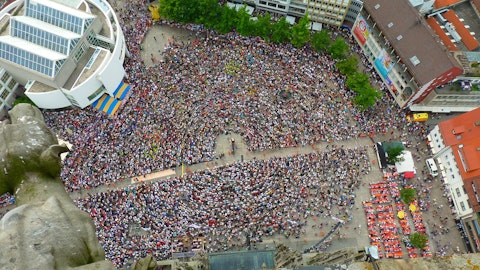We’ll see exactly what forms that takes over time. I think there are lots of forms that can take, but we view that as an opportunity as well. In general, they are very high-quality assets, these auto loans we generate, and the residuals offer, pretty significant returns that are very robust to increases in expected losses. And I think it’s a tried and true strategy for many in the industry to maintain those residuals and get paid pretty handsomely for it. So we think that’s an interesting opportunity. We’ll start to explore. We would like to maintain the right to do that flexibly over time, but that may be a change.
Rajat Gupta: Understood. Great. Thanks for the call, and good luck.
Ernie Garcia: Thank you.
Operator: Our next question comes from Chris Bottiglieri with BNP Paribas. Please go ahead.
Chris Bottiglieri: Yes, thanks for taking the question. So I just want to – I kind of want to clarify the new disclosure on the auto overhead expense. So your supplemental deck shows its $141 million, excluding DNA its $45 million. Is this largely the same bucket expenses as the $172 of other expenses in the core P&L? And I guess the way you’re framing it, it sounds like the vast majority of this $141 million plus the DNA are fixed, and that you need growth to scale. Is that the correct – Is that the correct way to frame it? Like how much of that is actually fixed versus variable? Because when I look at the way you define other expenses in the queue and just commentary given the past, it’s IT, it’s corporate occupancy, its professional services, it’s insurance, its limited warranty, its credit losses, customer swag.
Like some of those stuff sounds variable, and some of it sounds like you could cut it if you were structured. So kind of tell me the sense of how you’re thinking about that bucket from a fixed versus variable perspective going forward.
Mark Jenkins: Sure. I’ll take that one. So I think to hit the question very simply, the overhead expenses of $141 million are not the same as other SG&A expenses that we’ve historically reported. That new slide on overhead expenses per unit and also in dollar terms is intended to capture the more fixed components of both, compensation and benefits, as well as the more fixed components of other SG&A expenses. And so just to give some sense of what that is in compensation and benefits, that would be your corporate teams, accounting, legal, some of the more general and administrative-oriented corporate teams. It would also be your technology teams. So I think there, product, engineering, data science, those compensation benefits expenses would be included in that new overhead slide that we provided.
When you move to the other SG&A component, some of the expenses that underlie our historical other SG&A expense that would then be included in this new overhead expense measure would include facilities expenses. It would include some technology expenses, and then it would also include some non-payroll, other general and administrative expenses. And so that’s just to give a sense. And most importantly, with respect to the setup of your question, clarify that that is not – the new overhead expense measure is not a parallel or proxy for that other SG&A. Now, in terms of the question, what component of overhead expenses are fixed and what component are variable? So those expenses we view as primarily fixed. There are some semi-variable components.
For example, a few corporate departments may vary somewhat with units. Certain technology expenses may vary somewhat with units. But for the most part, those expenses are heavily fixed, and we think we have the ability to lever those expenses very significantly over time. And just to give a little bit more color on that last point, one of the reasons why we are really excited about the leverage opportunity that we see in front of us is our existing capacity utilization. And so as you probably saw in the shareholder letter or the accompanying materials, we have built and currently own significantly more capacity, whether it’s in our inspection and reconditioning centers or our logistics network, even our corporate office or not even corporate, but more sort of customer care center office space.
We own significantly more capacity than we are utilizing today. We think that gives us an opportunity to increase retail unit volume significantly, while levering those overhead expenses meaningfully in the process.
Chris Bottiglieri: I got you. Okay. So it sounds like its very much growth dependent. I mean, kind of leads to like a related follow-up. But I know you’re not willing to give guidance at this point for growth, but from our shoes, how do we think about growth? I mean, the market’s a little bit depressed, call it 10, 12 points. I think there’s probably some supply scarcity that’s caused you to lose market share that gets better over the next two, three, four years. But beyond that, like what are the – you have your tangible growth drivers like prime now like delivery, but how do you get to this 40%, 50% to 200% unit growth that you need to lever these fixed costs? Like what gives you comfort that you can get there? And from our shoes, like how do we model that? Like what does that mean for an investor?
Ernie Garcia: So, let me throw you that one. Let me start with this. I mean, I think until we really start to grow, these are all conceptual arguments and everyone has to decide kind of what they believe and what their expectation is, but I’ll start with ours. We expect to sell millions of cars. That has been our goal since the beginning. That is our absolute expectation, and I think a question to ask across time is, what has really changed versus the first eight years of our life where we grew very, very quickly? Because I think that it’s as hard to answer that question as it is or harder to answer that question than it is to answer how are we going to grow from here? During the early parts of our life, we grew at triple digit rates for a very long time and that took many forms.
It took – but I think the most exciting forms were basically a migration of people’s preferences toward e-commerce. It was a building of the car model brand. It was the positive feedback inherent in our business model. We are a business model that gets better as it gets bigger, and so it is true that when we grow inventory, selection goes up, conversion goes up. When conversion goes up, your advertising costs go down. You spend more on advertising, you sell more cars. That allows you to carry more inventory and there are several other examples of that as well. So I think those persistent drivers of growth led us to grow by multiples over an eight-year period of time. And then I think over the last year and a half, we’ve clearly been in a highly distorted environment, and I think that makes it a little bit harder to kind of read through and take the current trend lines and figure out exactly how to extend them.





